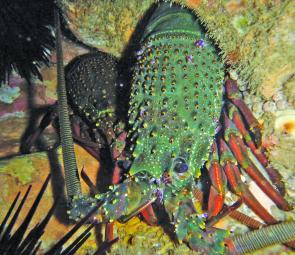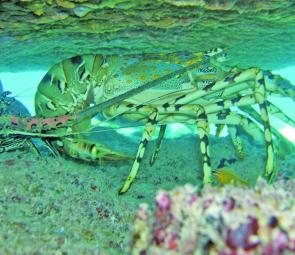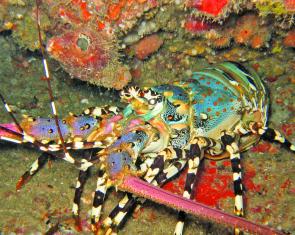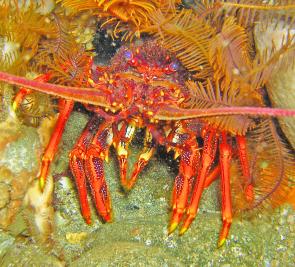Even though you have to brave the colder months for some species, one of the best ways to build up your diving skills is to go hunting for lobster. Here in Coffs Harbour it is the Eastern rock lobster (Jasus verreauxi) that is on the menu through the cooler months. And let's face it, a pretty damn good feed also!
There are a number of different species in Australia including:
Eastern rock lobster,
Western rock lobster,
Southern rock lobster,
Painted lobster,
Ornate lobster,
Coral lobster,
Slipper lobster.
The Eastern rock lobster is the largest spiny lobster in the world and can grow to over 10kg and live up to 20 years. The legal size range that can be taken in NSW is a minimum of 10.4cm and a maximum 18cm carapace length and egg bearing females must be returned to the water. This is a sensible practice of course as it allows for that one female to produce thousands of potential offspring. Not a bad trade off!
The NSW bag limit for Eastern rock lobster is 2 only. Lobster must also be taken with a gloved hand ONLY when diving in NSW, but you are allowed to use additional methods in other states: ALWAYS check your state and local regulations before venturing out. Enough rules and regulations, let's get on with it!
So the hunt begins soon after the water temperature drops below 20°C and we have had a winter big swell. Why the swell you might ask? It is a well know fact the Eastern rock lobster are much more mobile after a large swell and will move into the shallow coastal fringes.
Lobster can be found on just about any hard reef, but lobster holes are closely guarded secrets as lobster will return year after year to the same holes. You only really need some basic gear; mask, snorkel, fins, wetsuit, some thick gloves and a bag to stash your booty in!
Lobster, like every other marine species, has two overriding desires, procreation and sustenance! Taking advantage of the latter, lobster can often be found in caves and holes under bait schools, including yakkas, slimey mackerel and bullseyes. Not because they actively hunt baitfish, but they are great scavengers and no doubt pick up the scraps from species like snapper... I may have just said too much!
The easiest way to spot lobster is too look for their antenna that will often protrude from their hiding place and can be a dead giveaway. There is nothing like swimming over some shallow reef and seeing a dozen big antenna waving away on the bottom from inside a crevice. Also make sure you get down and have a good look as sometimes they can be hiding at the back of a cave.
Occasionally you can be lucky and they will just be sitting in a shallow crevice in amongst the weed. It’s not a bad habit to get into just floating on the surface watching the weed wash back and forth - you'll pick up their antenna. This is a great way to increase your chances of success as you can literally pickup them up off the bottom.
Octopus love to eat lobster, wobbegong eat octopus, so often you'll find lobster holed up with wobbegong - the bouncer at the door if you like! Sometime you'll have to get past the wobbegong to get to the lobster. Even though they look very docile, my advice after many years of hunting lobster and seeing just how quick and powerful wobbegong can be, find another hole! While we are on that subject NEVER shove your hand in anywhere were you can't see, for obvious reasons.
So you've found a hole with some nice lobster now it comes down to commitment. Often lobster are at the front of a deep hole you might only get one grab at them before they retreat into the depths of their hideaway. The best place to grab them is at the base of the antenna, or what is commonly referred to as the horns. The thick spiny part where the antenna join the body. They might look slow but lobster can make a retreat in the blink of an eye so you have to go in hard and fast shooting for the horns and once you get a hold don't let go!
Sometimes they'll bury down and lock themselves in place, wiggling them side to side will often release their hold. It can take some practise and I can nearly guarantee you'll miss on your first couple of attempts but perseverance is the key!
I have myriad lobster recipes, but some of my favourites include tempura lobster medallions cut from the tail. Very decadent but sensational with a drizzle of lime juice, sweet chill and olive oil and served on a bed of jasmine rice: 5 star. Lobster in black bean sauce, lobster thermidor (grilled with cheese sauce and melted cheese) and of course the humble BBQ lobster is always a winner. Damn I am suddenly hungry!
So I encourage you to take the plunge and get out and around you local rocky headlands on a nice day to kick things off. Of course always check your local conditions and be aware of localised hazards and don’t go jumping into croc infested waters! You will be truly amazed at the life and I am certain it will give you a whole new appreciation of Australia's beautiful coastline.
Until next time - safe diving!
Reads: 26362
Eastern rock lobster (Jasus verreauxi).

Painted spiny lobster (Panulirus versicolor).

Tropical rock lobster (Panulirus ornatus).

Southern Rocklobster (Jasus edwardsii).




